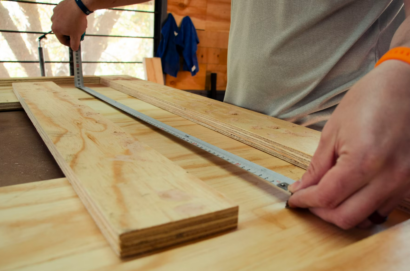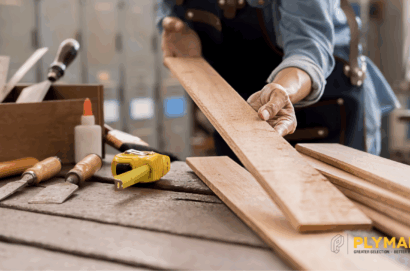Always low prices and perfect quality
When it comes to DIY projects or small-scale renovations, choosing the right materials can make or break your project. Plywood, a versatile and cost-effective material, is a popular choice for many applications. However, understanding plywood grades is essential to ensure you select the right type for your specific needs. These grades—ranging from A to D—determine the quality and appearance of the plywood’s surface. In this guide, we’ll break down the grading system and explain which grades are best suited for different projects. We’ll also link to Plyman’s products to help you find the perfect plywood for your next build.
What Are Plywood Grades?
Plywood grades are a classification system that indicates the quality of the face and back veneers of a plywood sheet. These grades provide insight into how smooth or rough the surface is, whether there are visible defects, and how suitable the plywood is for various applications.
The Four Main Grades:
- A-Grade: The highest quality with a smooth, sanded surface free of defects.
- B-Grade: Slightly lower quality than A-grade with minor imperfections like small knots or patches.
- C-Grade: Allows more visible flaws such as larger knots, splits, or discoloration.
- D-Grade: The lowest quality with numerous defects; typically used for structural or hidden applications.
Each grade serves a specific purpose, from decorative finishes to structural support. Let’s dive deeper into what each grade offers.
A-Grade Plywood
A-grade plywood is the crème de la crème of plywood options. It features a smooth, sanded surface that is free of knots, splits, or any major imperfections. This makes it ideal for projects where appearance matters most.
Best Uses:
- Furniture making (e.g., tables, chairs)
- Decorative wall panels
- Cabinetry with visible surfaces
- High-end DIY projects requiring a flawless finish
Why Choose A-Grade?
If you’re planning to stain or lacquer your plywood to highlight its natural beauty, A-grade is the way to go. Its premium finish ensures that your project looks professional and polished.
Plyman Product Recommendation:
For premium projects requiring top-notch quality, check out Plyman’s A-Grade Birch Plywood. Its smooth surface makes it perfect for furniture and cabinetry.
B-Grade Plywood
B-grade plywood is slightly less refined than A-grade but still offers a solid surface with minor imperfections. Small knots or patches may be present but are typically filled and sanded for an even finish.
Best Uses:
- Interior shelving
- Painted furniture
- Cabinet interiors
- Projects where one side will be visible and painted
Why Choose B-Grade?
B-grade plywood strikes a balance between quality and affordability. It’s great for projects where you plan to paint over the surface but still want a smooth base to work with.
Plyman Product Recommendation:
Plyman’s B/C Grade Plywood is an excellent option for semi-visible applications where cost-effectiveness meets quality.
C-Grade Plywood
C-grade plywood allows more visible flaws such as larger knots (up to 2.5 cm), splits, or discoloration. It’s not sanded as smoothly as higher grades but remains functional for structural purposes.
Best Uses:
- Subflooring
- Garage walls
- Structural sheathing
- Projects where appearance isn’t critical
Why Choose C-Grade?
If you’re working on a project where aesthetics aren’t a priority—like building subfloors or garage storage—C-grade plywood offers durability at an affordable price.
Plyman Product Recommendation:
For durable yet affordable panels, C/D H3.2 Treated Pine Structural Plywood is ideal for hidden or structural uses.
D-Grade Plywood
D-grade plywood is the lowest quality among the grades. It features numerous defects such as large knots, open holes, and rough surfaces. This grade is typically un-sanded and untreated.
Best Uses:
- Hidden structural applications
- Temporary construction
- Concrete formwork
Why Choose D-Grade?
While it lacks visual appeal, D-grade plywood excels in functionality for projects where it won’t be seen. It’s also budget-friendly, making it perfect for temporary builds or rough construction tasks.
Plyman Product Recommendation:
For economical solutions in non-visible areas, consider Plyman’s D-grade Utility Panels.
Grade Combinations: What Do Two Letters Mean?
Sometimes you’ll encounter plywood graded with two letters (e.g., A/C or B/B). These combinations indicate the quality of both the face veneer (the side intended to be visible) and the back veneer (the less visible side).
Examples:
- A/C Plywood: High-quality face veneer with a rougher back veneer; great for furniture where only one side will be visible.
- B/B Plywood: Both sides are smooth but may have minor imperfections; ideal for painted cabinets.
- C/D Plywood: Functional but rough on both sides; perfect for subfloors or structural use.
How to Choose the Right Grade for Your Project
Selecting the correct plywood grade depends on your project’s requirements. Here are some key factors to consider:
- Appearance Matters?
- If aesthetics are important (e.g., furniture or decorative panels), opt for A-grade or B-grade plywood.
- For hidden areas like subfloors or garage walls, C-grade or D-grade will suffice.
- Budget Constraints
- Higher grades like A and B come at a premium price but offer superior finishes.
- Lower grades like C and D are more affordable but may require additional prep work if appearance matters.
- Project Type
- Finish Plans
- If painting or staining, ensure you select a grade that matches your desired outcome (e.g., B-grade for painting).
Why Plyman Is Your Trusted Source
At Plyman, we understand that every project has unique needs. That’s why we offer an extensive range of plywood grades tailored to suit various applications—from high-end furniture making to budget-friendly structural builds. Our team of experts is always ready to guide you in selecting the right product for your project. Explore our full range of plywood products today and start building with confidence! Understanding plywood grades doesn’t have to be overwhelming. By knowing what each grade represents and matching it to your project requirements, you can make informed decisions that save time and money while ensuring professional results. Whether you’re crafting custom furniture or tackling home renovations, Plyman has the perfect panel waiting for you!



